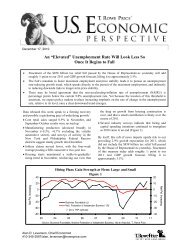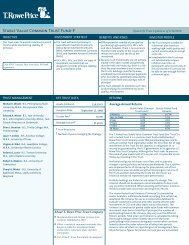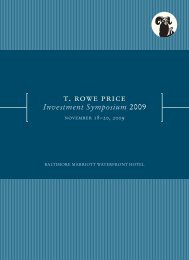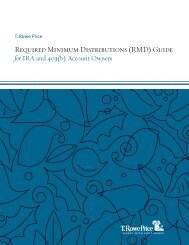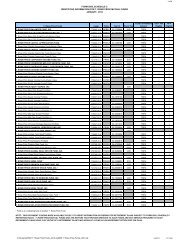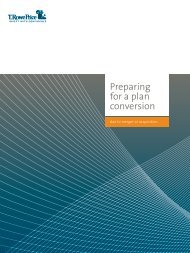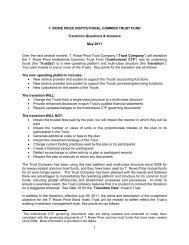YOUR ROLLOVER OPTIONS You are receiving this notice because ...
YOUR ROLLOVER OPTIONS You are receiving this notice because ...
YOUR ROLLOVER OPTIONS You are receiving this notice because ...
- No tags were found...
Create successful ePaper yourself
Turn your PDF publications into a flip-book with our unique Google optimized e-Paper software.
<strong>YOUR</strong> <strong>ROLLOVER</strong> <strong>OPTIONS</strong><br />
<strong>You</strong> <strong>are</strong> <strong>receiving</strong> <strong>this</strong> <strong>notice</strong> <strong>because</strong> all or a portion of a payment you receive from the Plan is eligible to be rolled<br />
over to an IRA or an employer plan. This <strong>notice</strong> is intended to help you decide whether to do such a rollover.<br />
This <strong>notice</strong> describes the rollover rules that apply to payments from the Plan that <strong>are</strong> not from a designated Roth<br />
account (a type of account with special tax rules in some employer plans). If you also receive a payment from a<br />
designated Roth account in the Plan, click here to skip to the <strong>notice</strong> for that payment type, and the Plan<br />
administrator or the payor will tell you the amount that is being paid from each account.<br />
Rules that apply to most payments from a plan <strong>are</strong> described in the “General Information About Rollovers” section.<br />
Special rules that only apply in certain circumstances <strong>are</strong> described in the “Special Rules and Options” section.<br />
How can a rollover affect my taxes?<br />
GENERAL INFORMATION ABOUT <strong>ROLLOVER</strong>S<br />
<strong>You</strong> will be taxed on a payment from the Plan if you do not roll it over. If you <strong>are</strong> under age 59½ and do not do a<br />
rollover, you will also have to pay a 10% additional income tax on early distributions (unless an exception applies).<br />
However, if you do a rollover, you will not have to pay tax until you receive payments later and the 10% additional<br />
income tax will not apply if those payments <strong>are</strong> made after you <strong>are</strong> age 59½ (or if an exception applies).<br />
Where may I roll over the payment?<br />
<strong>You</strong> may roll over the payment to either an IRA (an individual retirement account or individual retirement annuity) or an<br />
employer plan (a tax-qualified plan, section 403(b) plan, or governmental section 457(b) plan) that will accept the<br />
rollover. The rules of the IRA or employer plan that holds the rollover will determine your investment options, fees, and<br />
rights to payment from the IRA or employer plan (for example, no spousal consent rules apply to IRAs and IRAs may<br />
not provide loans). Further, the amount rolled over will become subject to the tax rules that apply to the IRA or<br />
employer plan.<br />
How do I do a rollover?<br />
There <strong>are</strong> two ways to do a rollover. <strong>You</strong> can do either a direct rollover or a 60-day rollover.<br />
If you do a direct rollover, the Plan will make the payment directly to your IRA or an employer plan. <strong>You</strong> should contact<br />
the IRA sponsor or the administrator of the employer plan for information on how to do a direct rollover.<br />
If you do not do a direct rollover, you may still do a rollover by making a deposit into an IRA or eligible employer plan<br />
that will accept it. <strong>You</strong> will have 60 days after you receive the payment to make the deposit. If you do not do a direct<br />
rollover, the Plan is required to withhold 20% of the payment for federal income taxes (up to the amount of cash and<br />
property received other than employer stock). This means that, in order to roll over the entire payment in a 60-day<br />
rollover, you must use other funds to make up for the 20% withheld. If you do not roll over the entire amount of the<br />
payment, the portion not rolled over will be taxed and will be subject to the 10% additional income tax on early<br />
distributions if you <strong>are</strong> under age 59½ (unless an exception applies).<br />
How much may I roll over?<br />
If you wish to do a rollover, you may roll over all or part of the amount eligible for rollover. Any payment from the Plan<br />
is eligible for rollover, except:<br />
• Certain payments spread over a period of at least 10 years or over your life or life expectancy (or the lives<br />
or joint life expectancy of you and your beneficiary)<br />
• Required minimum distributions after age 70½ (or after death)<br />
• Hardship distributions<br />
ROTH <strong>ROLLOVER</strong> NOTICE (Rev. 11/05/09) p. 1 OGY466-TRPAG 11/09
• ESOP dividends<br />
• Corrective distributions of contributions that exceed tax law limitations<br />
• Loans treated as deemed distributions (for example, loans in default due to missed payments before your<br />
employment ends) <br />
• Cost of life insurance paid by the Plan<br />
• Contributions made under special automatic enrollment rules that <strong>are</strong> withdrawn pursuant to your request<br />
within 90 days of enrollment<br />
• Amounts treated as distributed <strong>because</strong> of a prohibited allocation of S corporation stock under an ESOP<br />
(also, there will generally be adverse tax consequences if you roll over a distribution of S corporation stock<br />
to an IRA).<br />
The Plan administrator or the payor can tell you what portion of a payment is eligible for rollover.<br />
If I don’t do a rollover, will I have to pay the 10% additional income tax on early distributions?<br />
If you <strong>are</strong> under age 59½, you will have to pay the 10% additional income tax on early distributions for any payment<br />
from the Plan (including amounts withheld for income tax) that you do not roll over, unless one of the exceptions listed<br />
below applies. This tax is in addition to the regular income tax on the payment not rolled over.<br />
The 10% additional income tax does not apply to the following payments from the Plan:<br />
• Payments made after you separate from service if you will be at least age 55 in the year of the separation<br />
• Payments that start after you separate from service if paid at least annually in equal or close to equal<br />
amounts over your life or life expectancy (or the lives or joint life expectancy of you and your beneficiary)<br />
• Payments from a governmental defined benefit pension plan made after you separate from service if you<br />
<strong>are</strong> a public safety employee and you <strong>are</strong> at least age 50 in the year of the separation<br />
• Payments made due to disability<br />
• Payments after your death<br />
• Payments of ESOP dividends<br />
• Corrective distributions of contributions that exceed tax law limitations<br />
• Cost of life insurance paid by the Plan<br />
• Contributions made under special automatic enrollment rules that <strong>are</strong> withdrawn pursuant to your request<br />
within 90 days of enrollment<br />
• Payments made directly to the government to satisfy a federal tax levy<br />
• Payments made under a qualified domestic relations order (QDRO)<br />
• Payments up to the amount of your deductible medical expenses<br />
• Certain payments made while you <strong>are</strong> on active duty if you were a member of a reserve component called<br />
to duty after September 11, 2001 for more than 179 days<br />
• Payments of certain automatic enrollment contributions requested to be withdrawn within 90 days of the first<br />
contribution.<br />
If I do a rollover to an IRA, will the 10% additional income tax apply to early distributions from the IRA?<br />
If you receive a payment from an IRA when you <strong>are</strong> under age 59½, you will have to pay the 10% additional income<br />
tax on early distributions from the IRA, unless an exception applies. In general, the exceptions to the 10% additional<br />
income tax for early distributions from an IRA <strong>are</strong> the same as the exceptions listed above for early distributions from a<br />
plan. However, there <strong>are</strong> a few differences for payments from an IRA, including:<br />
• There is no exception for payments after separation from service that <strong>are</strong> made after age 55.<br />
• The exception for qualified domestic relations orders (QDROs) does not apply (although a special rule<br />
applies under which, as part of a divorce or separation agreement, a tax-free transfer may be made directly<br />
to an IRA of a spouse or former spouse).<br />
• The exception for payments made at least annually in equal or close to equal amounts over a specified<br />
period applies without regard to whether you have had a separation from service.<br />
• There <strong>are</strong> additional exceptions for (1) payments for qualified higher education expenses,<br />
(2) payments up to $10,000 used in a qualified first-time home purchase, and (3) payments after you have<br />
received unemployment compensation for 12 consecutive weeks (or would have been eligible to receive<br />
unemployment compensation but for self-employed status).<br />
ROTH <strong>ROLLOVER</strong> NOTICE (Rev. 11/05/09) p. 2 OGY466-TRPAG 11/09
Will I owe State income taxes?<br />
This <strong>notice</strong> does not describe any State or local income tax rules (including withholding rules).<br />
If your payment includes after-tax contributions<br />
SPECIAL RULES AND <strong>OPTIONS</strong><br />
After-tax contributions included in a payment <strong>are</strong> not taxed. If a payment is only part of your benefit, an allocable<br />
portion of your after-tax contributions is generally included in the payment. If you have pre-1987 after-tax contributions<br />
maintained in a separate account, a special rule may apply to determine whether the after-tax contributions <strong>are</strong><br />
included in a payment.<br />
<strong>You</strong> may roll over to an IRA a payment that includes after-tax contributions through either a direct rollover or a 60-day<br />
rollover. <strong>You</strong> must keep track of the aggregate amount of the after-tax contributions in all of your IRAs (in order to<br />
determine your taxable income for later payments from the IRAs). If you do a direct rollover of only a portion of the<br />
amount paid from the Plan and a portion is paid to you, each of the payments will include an allocable portion of the<br />
after-tax contributions. If you do a 60-day rollover to an IRA of only a portion of the payment made to you, the after-tax<br />
contributions <strong>are</strong> treated as rolled over last. For example, assume you <strong>are</strong> <strong>receiving</strong> a complete distribution of your<br />
benefit which totals $12,000, of which $2,000 is after-tax contributions. In <strong>this</strong> case, if you roll over $10,000 to an IRA<br />
in a 60-day rollover, no amount is taxable <strong>because</strong> the $2,000 amount not rolled over is treated as being after-tax<br />
contributions.<br />
<strong>You</strong> may roll over to an employer plan all of a payment that includes after-tax contributions, but only through a direct<br />
rollover (and only if the <strong>receiving</strong> plan separately accounts for after-tax contributions and is not a governmental section<br />
457(b) plan). <strong>You</strong> can do a 60-day rollover to an employer plan of part of a payment that includes after-tax<br />
contributions, but only up to the amount of the payment that would be taxable if not rolled over.<br />
If you miss the 60-day rollover deadline<br />
Generally, the 60-day rollover deadline cannot be extended. However, the IRS has the limited authority to waive the<br />
deadline under certain extraordinary circumstances, such as when external events prevented you from completing the<br />
rollover by the 60-day rollover deadline. To apply for a waiver, you must file a private letter ruling request with the IRS.<br />
Private letter ruling requests require the payment of a nonrefundable user fee. For more information, see IRS<br />
Publication 590, Individual Retirement Arrangements (IRAs).<br />
If your payment includes employer stock that you do not roll over<br />
If you do not do a rollover, you can apply a special rule to payments of employer stock (or other employer securities)<br />
that <strong>are</strong> either attributable to after-tax contributions or paid in a lump sum after separation from service (or after age<br />
59½, disability, or the participant’s death). Under the special rule, the net unrealized appreciation on the stock will not<br />
be taxed when distributed from the Plan and will be taxed at capital gain rates when you sell the stock. Net unrealized<br />
appreciation is generally the increase in the value of employer stock after it was acquired by the Plan. If you do a<br />
rollover for a payment that includes employer stock (for example, by selling the stock and rolling over the proceeds<br />
within 60 days of the payment), the special rule relating to the distributed employer stock will not apply to any<br />
subsequent payments from the IRA or employer plan. The Plan administrator can tell you the amount of any net<br />
unrealized appreciation.<br />
If you have an outstanding loan that is being offset<br />
If you have an outstanding loan from the Plan, your Plan benefit may be offset by the amount of the loan, typically<br />
when your employment ends. The loan offset amount is treated as a distribution to you at the time of the offset and will<br />
be taxed (including the 10% additional income tax on early distributions, unless an exception applies) unless you do a<br />
60-day rollover in the amount of the loan offset to an IRA or employer plan.<br />
ROTH <strong>ROLLOVER</strong> NOTICE (Rev. 11/05/09) p. 3 OGY466-TRPAG 11/09
If you were born on or before January 1, 1936<br />
If you were born on or before January 1, 1936 and receive a lump sum distribution that you do not roll over, special<br />
rules for calculating the amount of the tax on the payment might apply to you. For more information, see IRS<br />
Publication 575, Pension and Annuity Income.<br />
If your payment is from a governmental section 457(b) plan<br />
If the Plan is a governmental section 457(b) plan, the same rules described elsewhere in <strong>this</strong> <strong>notice</strong> generally apply,<br />
allowing you to roll over the payment to an IRA or an employer plan that accepts rollovers. One difference is that, if<br />
you do not do a rollover, you will not have to pay the 10% additional income tax on early distributions from the Plan<br />
even if you <strong>are</strong> under age 59½ (unless the payment is from a separate account holding rollover contributions that were<br />
made to the Plan from a tax-qualified plan, a section 403(b) plan, or an IRA). However, if you do a rollover to an IRA<br />
or to an employer plan that is not a governmental section 457(b) plan, a later distribution made before age 59½ will be<br />
subject to the 10% additional income tax on early distributions (unless an exception applies). Other differences <strong>are</strong><br />
that you cannot do a rollover if the payment is due to an “unforeseeable emergency” and the special rules under “If<br />
your payment includes employer stock that you do not roll over” and “If you were born on or before January 1, 1936”<br />
do not apply.<br />
If you <strong>are</strong> an eligible retired public safety officer and your pension payment is used to pay for health coverage<br />
or qualified long-term c<strong>are</strong> insurance<br />
If the Plan is a governmental plan, you retired as a public safety officer, and your retirement was by reason of disability<br />
or was after normal retirement age, you can exclude from your taxable income plan payments paid directly as<br />
premiums to an accident or health plan (or a qualified long-term c<strong>are</strong> insurance contract) that your employer maintains<br />
for you, your spouse, or your dependents, up to a maximum of $3,000 annually. For <strong>this</strong> purpose, a public safety<br />
officer is a law enforcement officer, firefighter, chaplain, or member of a rescue squad or ambulance crew.<br />
If you roll over your payment to a Roth IRA<br />
<strong>You</strong> can roll over a payment from the Plan made before January 1, 2010 to a Roth IRA only if your modified adjusted<br />
gross income is not more than $100,000 for the year the payment is made to you and, if married, you file a joint return.<br />
These limitations do not apply to payments made to you from the Plan after 2009. If you wish to roll over the payment<br />
to a Roth IRA, but you <strong>are</strong> not eligible to do a rollover to a Roth IRA until after 2009, you can do a rollover to a<br />
traditional IRA and then, after 2009, elect to convert the traditional IRA into a Roth IRA.<br />
If you roll over the payment to a Roth IRA, a special rule applies under which the amount of the payment rolled over<br />
(reduced by any after-tax amounts) will be taxed. However, the 10% additional income tax on early distributions will<br />
not apply (unless you take the amount rolled over out of the Roth IRA within 5 years, counting from January 1 of the<br />
year of the rollover). For payments from the Plan during 2010 that <strong>are</strong> rolled over to a Roth IRA, the taxable amount<br />
can be spread over a 2-year period starting in 2011.<br />
If you roll over the payment to a Roth IRA, later payments from the Roth IRA that <strong>are</strong> qualified distributions will not be<br />
taxed (including earnings after the rollover). A qualified distribution from a Roth IRA is a payment made after you <strong>are</strong><br />
age 59½ (or after your death or disability, or as a qualified first-time homebuyer distribution of up to $10,000) and after<br />
you have had a Roth IRA for at least 5 years. In applying <strong>this</strong> 5-year rule, you count from January 1 of the year for<br />
which your first contribution was made to a Roth IRA. Payments from the Roth IRA that <strong>are</strong> not qualified distributions<br />
will be taxed to the extent of earnings after the rollover, including the 10% additional income tax on early distributions<br />
(unless an exception applies). <strong>You</strong> do not have to take required minimum distributions from a Roth IRA during your<br />
lifetime. For more information, see IRS Publication 590, Individual Retirement Arrangements (IRAs).<br />
<strong>You</strong> cannot roll over a payment from the Plan to a designated Roth account in an employer plan.<br />
ROTH <strong>ROLLOVER</strong> NOTICE (Rev. 11/05/09) p. 4 OGY466-TRPAG 11/09
If you <strong>are</strong> not a plan participant<br />
Payments after death of the participant. If you receive a distribution after the participant’s death that you do not roll<br />
over, the distribution will generally be taxed in the same manner described elsewhere in <strong>this</strong> <strong>notice</strong>. However, the 10%<br />
additional income tax on early distributions and the special rules for public safety officers do not apply, and the special<br />
rule described under the section “If you were born on or before January 1, 1936” applies only if the participant was<br />
born on or before January 1, 1936.<br />
If you <strong>are</strong> a surviving spouse. If you receive a payment from the Plan as the surviving spouse of a deceased<br />
participant, you have the same rollover options that the participant would have had, as described elsewhere in<br />
<strong>this</strong> <strong>notice</strong>. In addition, if you choose to do a rollover to an IRA, you may treat the IRA as your own or as an<br />
inherited IRA.<br />
An IRA you treat as your own is treated like any other IRA of yours, so that payments made to you before you<br />
<strong>are</strong> age 59½ will be subject to the 10% additional income tax on early distributions (unless an exception<br />
applies) and required minimum distributions from your IRA do not have to start until after you <strong>are</strong> age 70½.<br />
If you treat the IRA as an inherited IRA, payments from the IRA will not be subject to the 10% additional<br />
income tax on early distributions. However, if the participant had started taking required minimum<br />
distributions, you will have to receive required minimum distributions from the inherited IRA. If the participant<br />
had not started taking required minimum distributions from the Plan, you will not have to start <strong>receiving</strong><br />
required minimum distributions from the inherited IRA until the year the participant would have been age 70½.<br />
If you <strong>are</strong> a surviving beneficiary other than a spouse. If you receive a payment from the Plan <strong>because</strong> of<br />
the participant’s death and you <strong>are</strong> a designated beneficiary other than a surviving spouse, the only rollover<br />
option you have is to do a direct rollover to an inherited IRA. Payments from the inherited IRA will not be<br />
subject to the 10% additional income tax on early distributions. <strong>You</strong> will have to receive required minimum<br />
distributions from the inherited IRA.<br />
Payments under a qualified domestic relations order. If you <strong>are</strong> the spouse or former spouse of the participant who<br />
receives a payment from the Plan under a qualified domestic relations order (QDRO), you generally have the same<br />
options the participant would have (for example, you may roll over the payment to your own IRA or an eligible<br />
employer plan that will accept it). Payments under the QDRO will not be subject to the 10% additional income tax on<br />
early distributions.<br />
If you <strong>are</strong> a nonresident alien<br />
If you <strong>are</strong> a nonresident alien and you do not do a direct rollover to a U.S. IRA or U.S. employer plan, instead of<br />
withholding 20%, the Plan is generally required to withhold 30% of the payment for federal income taxes. If the<br />
amount withheld exceeds the amount of tax you owe (as may happen if you do a 60-day rollover), you may request an<br />
income tax refund by filing Form 1040NR and attaching your Form 1042-S. See Form W-8BEN for claiming that you<br />
<strong>are</strong> entitled to a reduced rate of withholding under an income tax treaty. For more information, see also IRS<br />
Publication 519, U.S. Tax Guide for Aliens, and IRS Publication 515, Withholding of Tax on Nonresident Aliens and<br />
Foreign Entities.<br />
Other special rules<br />
If a payment is one in a series of payments for less than 10 years, your choice whether to make a direct rollover will<br />
apply to all later payments in the series (unless you make a different choice for later payments).<br />
If your payments for the year <strong>are</strong> less than $200 (not including payments from a designated Roth account in the Plan),<br />
the Plan is not required to allow you to do a direct rollover and is not required to withhold for federal income taxes.<br />
However, you may do a 60-day rollover.<br />
ROTH <strong>ROLLOVER</strong> NOTICE (Rev. 11/05/09) p. 5 OGY466-TRPAG 11/09
Unless you elect otherwise, a mandatory cashout of more than $1,000 (not including payments from a designated Roth<br />
account in the Plan) will be directly rolled over to an IRA chosen by the Plan administrator or the payor. A mandatory<br />
cashout is a payment from a plan to a participant made before age 62 (or normal retirement age, if later) and without<br />
consent, where the participant’s benefit does not exceed $5,000 (not including any amounts held under the plan as a<br />
result of a prior rollover made to the plan, if so elected by the plan).<br />
<strong>You</strong> may have special rollover rights if you recently served in the U.S. Armed Forces. For more information, see IRS<br />
Publication 3, Armed Forces’ Tax Guide.<br />
FOR MORE INFORMATION<br />
<strong>You</strong> may wish to consult with the Plan administrator or payor, or a professional tax advisor, before taking a payment<br />
from the Plan. Also, you can find more detailed information on the federal tax treatment of payments from employer<br />
plans in: IRS Publication 575, Pension and Annuity Income; IRS Publication 590, Individual Retirement Arrangements<br />
(IRAs); and IRS Publication 571, Tax-Sheltered Annuity Plans (403(b) Plans). These publications <strong>are</strong> available from a<br />
local IRS office, on the web at www.irs.gov, or by calling 1-800-TAX-FORM.<br />
ROTH <strong>ROLLOVER</strong> NOTICE (Rev. 11/05/09) p. 6 OGY466-TRPAG 11/09
FOR PAYMENTS FROM A DESIGNATED ROTH ACCOUNT<br />
<strong>YOUR</strong> <strong>ROLLOVER</strong> <strong>OPTIONS</strong><br />
<strong>You</strong> <strong>are</strong> <strong>receiving</strong> <strong>this</strong> <strong>notice</strong> <strong>because</strong> all or a portion of a payment you receive from the Plan is eligible to be rolled<br />
over to a Roth IRA or designated Roth account in an employer plan. This <strong>notice</strong> is intended to help you decide<br />
whether to do a rollover.<br />
This <strong>notice</strong> describes the rollover rules that apply to payments from the Plan that <strong>are</strong> from a designated Roth account.<br />
If you also receive a payment from the Plan that is not from a designated Roth account, you will be provided a different<br />
<strong>notice</strong> for that payment, and the Plan administrator or the payor will tell you the amount that is being paid from each<br />
account.<br />
Rules that apply to most payments from a designated Roth account <strong>are</strong> described in the “General Information About<br />
Rollovers” section. Special rules that only apply in certain circumstances <strong>are</strong> described in the “Special Rules and<br />
Options” section.<br />
How can a rollover affect my taxes?<br />
GENERAL INFORMATION ABOUT <strong>ROLLOVER</strong>S<br />
After-tax contributions included in a payment from a designated Roth account <strong>are</strong> not taxed, but earnings might be<br />
taxed. The tax treatment of earnings included in the payment depends on whether the payment is a qualified<br />
distribution. If a payment is only part of your designated Roth account, the payment will include an allocable portion of<br />
the earnings in your designated Roth account.<br />
If the payment from the Plan is not a qualified distribution and you do not do a rollover to a Roth IRA or a designated<br />
Roth account in an employer plan, you will be taxed on the earnings in the payment. If you <strong>are</strong> under age 59½, a 10%<br />
additional income tax on early distributions will also apply to the earnings (unless an exception applies). However, if<br />
you do a rollover, you will not have to pay taxes currently on the earnings and you will not have to pay taxes later on<br />
payments that <strong>are</strong> qualified distributions.<br />
If the payment from the Plan is a qualified distribution, you will not be taxed on any part of the payment even if you do<br />
not do a rollover. If you do a rollover, you will not be taxed on the amount you roll over and any earnings on the<br />
amount you roll over will not be taxed if paid later in a qualified distribution.<br />
A qualified distribution from a designated Roth account in the Plan is a payment made after you <strong>are</strong> age 59½ (or after<br />
your death or disability) and after you have had a designated Roth account in the Plan for at least 5 years. In applying<br />
the 5-year rule, you count from January 1 of the year your first contribution was made to the designated Roth account.<br />
However, if you did a direct rollover to a designated Roth account in the Plan from a designated Roth account in<br />
another employer plan, your participation will count from January 1 of the year your first contribution was made to the<br />
designated Roth account in the Plan or, if earlier, to the designated Roth account in the other employer plan.<br />
Where may I roll over the payment?<br />
<strong>You</strong> may roll over the payment to either a Roth IRA (a Roth individual retirement account or Roth individual retirement<br />
annuity) or a designated Roth account in an employer plan (a tax-qualified plan or section 403(b) plan) that will accept<br />
the rollover. The rules of the Roth IRA or employer plan that holds the rollover will determine your investment options,<br />
fees, and rights to payment from the Roth IRA or employer plan (for example, no spousal consent rules apply to Roth<br />
IRAs and Roth IRAs may not provide loans). Further, the amount rolled over will become subject to the tax rules that<br />
apply to the Roth IRA or the designated Roth account in the employer plan. In general, these tax rules <strong>are</strong> similar to<br />
those described elsewhere in <strong>this</strong> <strong>notice</strong>, but differences include:<br />
• If you do a rollover to a Roth IRA, all of your Roth IRAs will be considered for purposes of determining<br />
whether you have satisfied the 5-year rule (counting from January 1 of the year for which your first<br />
contribution was made to any of your Roth IRAs).<br />
ROTH <strong>ROLLOVER</strong> NOTICE (Rev. 11/05/09) p. 7 OGY466-TRPAG 11/09
• If you do a rollover to a Roth IRA, you will not be required to take a distribution from the Roth IRA<br />
during your lifetime and you must keep track of the aggregate amount of the after-tax contributions in<br />
all of your Roth IRAs (in order to determine your taxable income for later Roth IRA payments that <strong>are</strong><br />
not qualified distributions).<br />
• Eligible rollover distributions from a Roth IRA can only be rolled over to another Roth IRA.<br />
How do I do a rollover?<br />
There <strong>are</strong> two ways to do a rollover. <strong>You</strong> can either do a direct rollover or a 60-day rollover.<br />
If you do a direct rollover, the Plan will make the payment directly to your Roth IRA or designated Roth account in an<br />
employer plan. <strong>You</strong> should contact the Roth IRA sponsor or the administrator of the employer plan for information on<br />
how to do a direct rollover.<br />
If you do not do a direct rollover, you may still do a rollover by making a deposit within 60 days into a Roth IRA,<br />
whether the payment is a qualified or nonqualified distribution. In addition, you can do a rollover by making a deposit<br />
within 60 days into a designated Roth account in an employer plan if the payment is a nonqualified distribution and the<br />
rollover does not exceed the amount of the earnings in the payment. <strong>You</strong> cannot do a 60-day rollover to an employer<br />
plan of any part of a qualified distribution. If you receive a distribution that is a nonqualified distribution and you do not<br />
roll over an amount at least equal to the earnings allocable to the distribution, you will be taxed on the amount of those<br />
earnings not rolled over, including the 10% additional income tax on early distributions if you <strong>are</strong> under age 59½<br />
(unless an exception applies).<br />
If you do a direct rollover of only a portion of the amount paid from the Plan and a portion is paid to you, each of the<br />
payments will include an allocable portion of the earnings in your designated Roth account.<br />
If you do not do a direct rollover and the payment is not a qualified distribution, the Plan is required to withhold 20% of<br />
the earnings for federal income taxes (up to the amount of cash and property received other than employer stock).<br />
This means that, in order to roll over the entire payment in a 60-day rollover to a Roth IRA, you must use other funds to<br />
make up for the 20% withheld.<br />
How much may I roll over?<br />
If you wish to do a rollover, you may roll over all or part of the amount eligible for rollover. Any payment from the Plan<br />
is eligible for rollover, except:<br />
• Certain payments spread over a period of at least 10 years or over your life or life expectancy (or the<br />
lives or joint life expectancy of you and your beneficiary)<br />
• Required minimum distributions after age 70½ (or after death)<br />
• Hardship distributions<br />
• ESOP dividends<br />
• Corrective distributions of contributions that exceed tax law limitations<br />
• Loans treated as deemed distributions (for example, loans in default due to missed payments before<br />
your employment ends)<br />
• Cost of life insurance paid by the Plan<br />
• Contributions made under special automatic enrollment rules that <strong>are</strong> withdrawn pursuant to your<br />
request within 90 days of enrollment<br />
• Amounts treated as distributed <strong>because</strong> of a prohibited allocation of S corporation stock under an<br />
ESOP (also, there will generally be adverse tax consequences if S corporation stock is held by an<br />
IRA).<br />
The Plan administrator or the payor can tell you what portion of a payment is eligible for rollover.<br />
If I don’t do a rollover, will I have to pay the 10% additional income tax on early distributions?<br />
If a payment is not a qualified distribution and you <strong>are</strong> under age 59½, you will have to pay the 10% additional income<br />
tax on early distributions with respect to the earnings allocated to the payment that you do not roll over (including<br />
amounts withheld for income tax), unless one of the exceptions listed below applies. This tax is in addition to the<br />
ROTH <strong>ROLLOVER</strong> NOTICE (Rev. 11/05/09) p. 8 OGY466-TRPAG 11/09
egular income tax on the earnings not rolled over.<br />
The 10% additional income tax does not apply to the following payments from the Plan:<br />
• Payments made after you separate from service if you will be at least age 55 in the year of the<br />
separation<br />
• Payments that start after you separate from service if paid at least annually in equal or close to equal<br />
amounts over your life or life expectancy (or the lives or joint life expectancy of you and your<br />
beneficiary)<br />
• Payments made due to disability<br />
• Payments after your death<br />
• Payments of ESOP dividends<br />
• Corrective distributions of contributions that exceed tax law limitations<br />
• Cost of life insurance paid by the Plan<br />
• Contributions made under special automatic enrollment rules that <strong>are</strong> withdrawn pursuant to your<br />
request within 90 days of enrollment<br />
• Payments made directly to the government to satisfy a federal tax levy<br />
• Payments made under a qualified domestic relations order (QDRO)<br />
• Payments up to the amount of your deductible medical expenses<br />
• Certain payments made while you <strong>are</strong> on active duty if you were a member of a reserve component<br />
called to duty after September 11, 2001 for more than 179 days<br />
• Payments of certain automatic enrollment contributions requested to be withdrawn within 90 days of<br />
the first contribution.<br />
If I do a rollover to a Roth IRA, will the 10% additional income tax apply to early distributions from the IRA?<br />
If you receive a payment from a Roth IRA when you <strong>are</strong> under age 59½, you will have to pay the 10% additional<br />
income tax on early distributions on the earnings paid from the Roth IRA, unless an exception applies or the payment<br />
is a qualified distribution. In general, the exceptions to the 10% additional income tax for early distributions from a<br />
Roth IRA listed above <strong>are</strong> the same as the exceptions for early distributions from a plan. However, there <strong>are</strong> a few<br />
differences for payments from a Roth IRA, including:<br />
• There is no special exception for payments after separation from service.<br />
• The exception for qualified domestic relations orders (QDROs) does not apply (although a special rule<br />
applies under which, as part of a divorce or separation agreement, a tax-free transfer may be made<br />
directly to a Roth IRA of a spouse or former spouse).<br />
• The exception for payments made at least annually in equal or close to equal amounts over a specified<br />
period applies without regard to whether you have had a separation from service.<br />
• There <strong>are</strong> additional exceptions for (1) payments for qualified higher education expenses, (2)<br />
payments up to $10,000 used in a qualified first-time home purchase, and (3) payments after you have<br />
received unemployment compensation for 12 consecutive weeks (or would have been eligible to<br />
receive unemployment compensation but for self-employed status).<br />
Will I owe State income taxes?<br />
This <strong>notice</strong> does not describe any State or local income tax rules (including withholding rules).<br />
If you miss the 60-day rollover deadline<br />
SPECIAL RULES AND <strong>OPTIONS</strong><br />
Generally, the 60-day rollover deadline cannot be extended. However, the IRS has the limited authority to waive the<br />
deadline under certain extraordinary circumstances, such as when external events prevented you from completing the<br />
rollover by the 60-day rollover deadline. To apply for a waiver, you must file a private letter ruling request with the IRS.<br />
Private letter ruling requests require the payment of a nonrefundable user fee. For more information, see IRS<br />
Publication 590, Individual Retirement Arrangements (IRAs).<br />
If your payment includes employer stock that you do not roll over<br />
If you receive a payment that is not a qualified distribution and you do not roll it over, you can apply a special rule to<br />
payments of employer stock (or other employer securities) that <strong>are</strong> paid in a lump sum after separation from service (or<br />
ROTH <strong>ROLLOVER</strong> NOTICE (Rev. 11/05/09) p. 9 OGY466-TRPAG 11/09
after age 59½, disability, or the participant’s death). Under the special rule, the net unrealized appreciation on the<br />
stock included in the earnings in the payment will not be taxed when distributed to you from the Plan and will be taxed<br />
at capital gain rates when you sell the stock. If you do a rollover to a Roth IRA for a nonqualified distribution that<br />
includes employer stock (for example, by selling the stock and rolling over the proceeds within 60 days of the<br />
distribution), you will not have any taxable income and the special rule relating to the distributed employer stock will not<br />
apply to any subsequent payments from the Roth IRA or employer plan. Net unrealized appreciation is generally the<br />
increase in the value of the employer stock after it was acquired by the Plan. The Plan administrator can tell you the<br />
amount of any net unrealized appreciation.<br />
If you receive a payment that is a qualified distribution that includes employer stock and you do not roll it over, your<br />
basis in the stock (used to determine gain or loss when you later sell the stock) will equal the fair market value of the<br />
stock at the time of the payment from the Plan.<br />
If you have an outstanding loan that is being offset<br />
If you have an outstanding loan from the Plan, your Plan benefit may be offset by the amount of the loan, typically<br />
when your employment ends. The loan offset amount is treated as a distribution to you at the time of the offset and, if<br />
the distribution is a nonqualified distribution, the earnings in the loan offset will be taxed (including the 10% additional<br />
income tax on early distributions, unless an exception applies) unless you do a 60-day rollover in the amount of the<br />
earnings in the loan offset to a Roth IRA or designated Roth account in an employer plan.<br />
If you receive a nonqualified distribution and you were born on or before January 1, 1936<br />
If you were born on or before January 1, 1936, and receive a lump sum distribution that is not a qualified distribution<br />
and that you do not roll over, special rules for calculating the amount of the tax on the earnings in the payment might<br />
apply to you. For more information, see IRS Publication 575, Pension and Annuity Income.<br />
If you receive a nonqualified distribution, <strong>are</strong> an eligible retired public safety officer, and your pension<br />
payment is used to pay for health coverage or qualified long-term c<strong>are</strong> insurance<br />
If the Plan is a governmental plan, you retired as a public safety officer, and your retirement was by reason of disability<br />
or was after normal retirement age, you can exclude from your taxable income nonqualified distributions paid directly<br />
as premiums to an accident or health plan (or a qualified long-term c<strong>are</strong> insurance contract) that your employer<br />
maintains for you, your spouse, or your dependents, up to a maximum of $3,000 annually. For <strong>this</strong> purpose, a public<br />
safety officer is a law enforcement officer, firefighter, chaplain, or member of a rescue squad or ambulance crew.<br />
If you <strong>are</strong> not a plan participant<br />
Payments after death of the participant. If you receive a distribution after the participant’s death that you do not roll<br />
over, the distribution will generally be taxed in the same manner described elsewhere in <strong>this</strong> <strong>notice</strong>. However, whether<br />
the payment is a qualified distribution generally depends on when the participant first made a contribution to the<br />
designated Roth account in the Plan. Also, the 10% additional income tax on early distributions and the special rules<br />
for public safety officers do not apply, and the special rule described under the section “If you receive a nonqualified<br />
distribution and you were born on or before January 1, 1936” applies only if the participant was born on or before<br />
January 1, 1936.<br />
If you <strong>are</strong> a surviving spouse. If you receive a payment from the Plan as the surviving spouse of a deceased<br />
participant, you have the same rollover options that the participant would have had, as described elsewhere in<br />
<strong>this</strong> <strong>notice</strong>. In addition, if you choose to do a rollover to a Roth IRA, you may treat the Roth IRA as your own or<br />
as an inherited Roth IRA.<br />
A Roth IRA you treat as your own is treated like any other Roth IRA of yours, so that you will not have to<br />
receive any required minimum distributions during your lifetime and earnings paid to you in a nonqualified<br />
distribution before you <strong>are</strong> age 59½ will be subject to the 10% additional income tax on early distributions<br />
(unless an exception applies).<br />
ROTH <strong>ROLLOVER</strong> NOTICE (Rev. 11/05/09) p. 10 OGY466-TRPAG 11/09
If you treat the Roth IRA as an inherited Roth IRA, payments from the Roth IRA will not be subject to the 10%<br />
additional income tax on early distributions. An inherited Roth IRA is subject to required minimum<br />
distributions. If the participant had started taking required minimum distributions from the Plan, you will have to<br />
receive required minimum distributions from the inherited Roth IRA. If the participant had not started taking<br />
required minimum distributions, you will not have to start <strong>receiving</strong> required minimum distributions from the<br />
inherited Roth IRA until the year the participant would have been age 70½.<br />
If you <strong>are</strong> a surviving beneficiary other than a spouse. If you receive a payment from the Plan <strong>because</strong> of<br />
the participant’s death and you <strong>are</strong> a designated beneficiary other than a surviving spouse, the only rollover<br />
option you have is to do a direct rollover to an inherited Roth IRA. Payments from the inherited Roth IRA, even<br />
if made in a nonqualified distribution, will not be subject to the 10% additional income tax on early distributions.<br />
<strong>You</strong> will have to receive required minimum distributions from the inherited Roth IRA.<br />
Payments under a qualified domestic relations order. If you <strong>are</strong> the spouse or a former spouse of the participant who<br />
receives a payment from the Plan under a qualified domestic relations order (QDRO), you generally have the same<br />
options the participant would have (for example, you may roll over the payment as described in <strong>this</strong> <strong>notice</strong>).<br />
If you <strong>are</strong> a nonresident alien<br />
If you <strong>are</strong> a nonresident alien and you do not do a direct rollover to a U.S. IRA or U.S. employer plan, instead of<br />
withholding 20%, the Plan is generally required to withhold 30% of the payment for federal income taxes. If the<br />
amount withheld exceeds the amount of tax you owe (as may happen if you do a 60-day rollover), you may request an<br />
income tax refund by filing Form 1040NR and attaching your Form 1042-S. See Form W-8BEN for claiming that you<br />
<strong>are</strong> entitled to a reduced rate of withholding under an income tax treaty. For more information, see also IRS<br />
Publication 519, U.S. Tax Guide for Aliens, and IRS Publication 515, Withholding of Tax on Nonresident Aliens and<br />
Foreign Entities.<br />
Other special rules<br />
If a payment is one in a series of payments for less than 10 years, your choice whether to make a direct rollover will<br />
apply to all later payments in the series (unless you make a different choice for later payments).<br />
If your payments for the year (only including payments from the designated Roth account in the Plan) <strong>are</strong> less than<br />
$200, the Plan is not required to allow you to do a direct rollover and is not required to withhold for federal income<br />
taxes. However, you can do a 60-day rollover.<br />
Unless you elect otherwise, a mandatory cashout from the designated Roth account in the Plan of more than $1,000<br />
will be directly rolled over to a Roth IRA chosen by the Plan administrator or the payor. A mandatory cashout is a<br />
payment from a plan to a participant made before age 62 (or normal retirement age, if later) and without consent,<br />
where the participant’s benefit does not exceed $5,000 (not including any amounts held under the plan as a result of a<br />
prior rollover made to the plan, if so elected by the plan).<br />
<strong>You</strong> may have special rollover rights if you recently served in the U.S. Armed Forces. For more information, see IRS<br />
Publication 3, Armed Forces’ Tax Guide.<br />
FOR MORE INFORMATION<br />
<strong>You</strong> may wish to consult with the Plan administrator or payor, or a professional tax advisor, before taking a payment<br />
from the Plan. Also, you can find more detailed information on the federal tax treatment of payments from employer<br />
plans in: IRS Publication 575, Pension and Annuity Income; IRS Publication 590, Individual Retirement Arrangements<br />
(IRAs); and IRS Publication 571, Tax-Sheltered Annuity Plans (403(b) Plans). These publications <strong>are</strong> available from a<br />
local IRS office, on the web at www.irs.gov, or by calling 1-800-TAX-FORM.<br />
ROTH <strong>ROLLOVER</strong> NOTICE (Rev. 11/05/09) p. 11 OGY466-TRPAG 11/09



